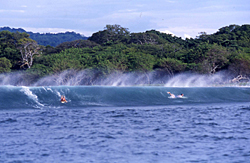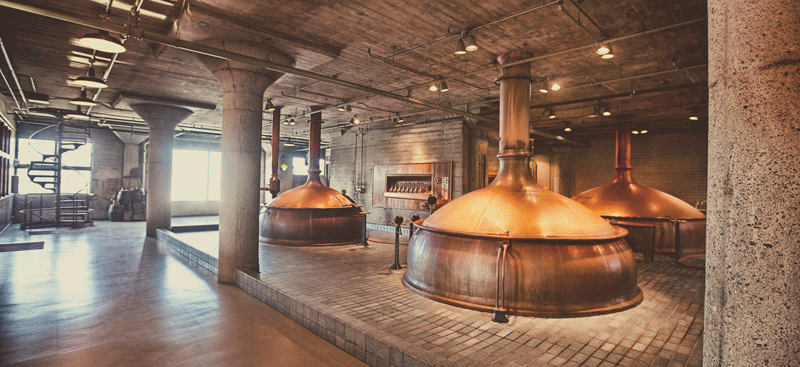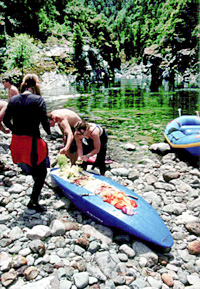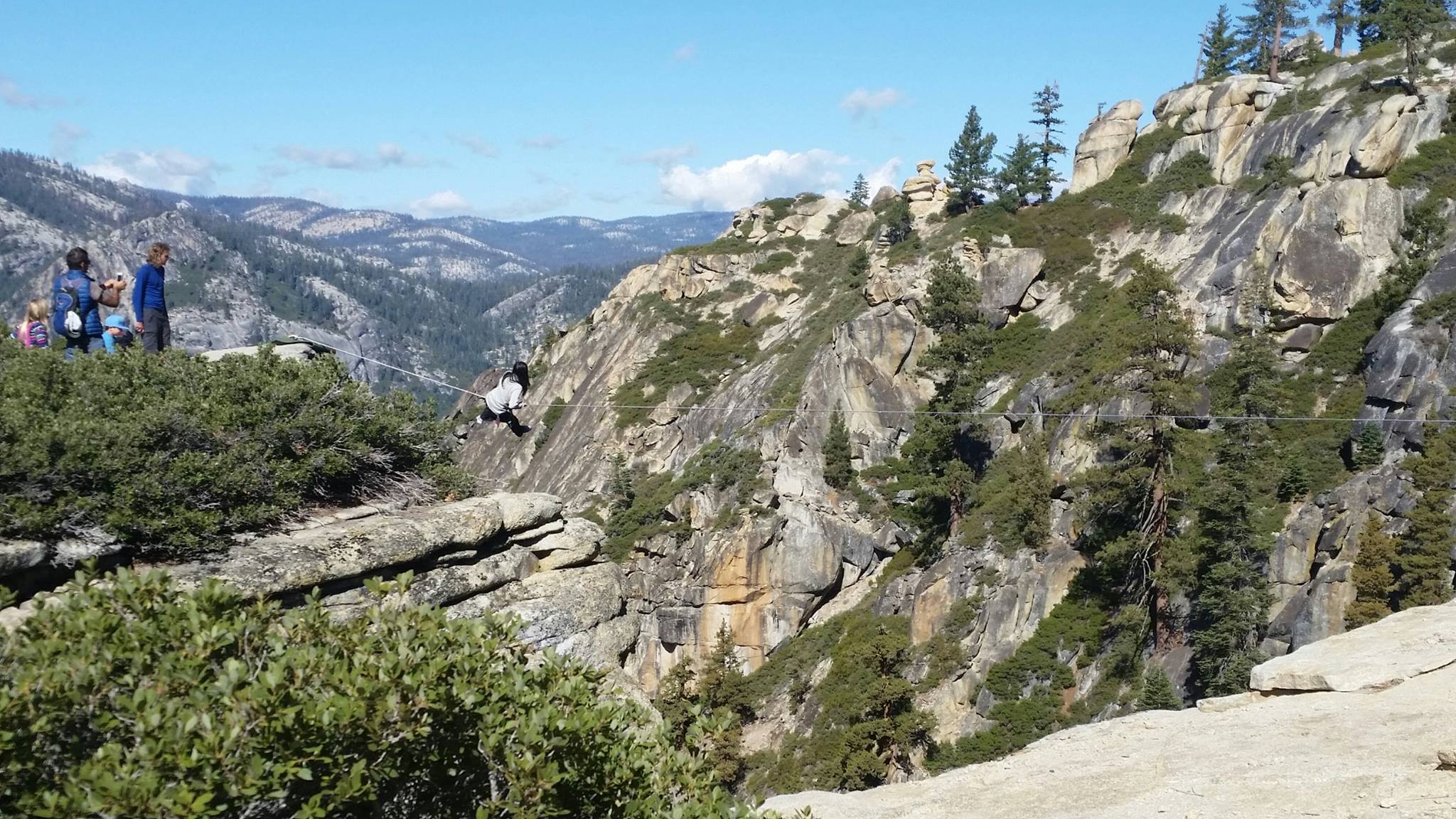- Tahoe’s Nevada Beach Tops the List of Hard-to-Book Campgrounds - 07/17/2024
- Cannabis Watershed Protection Program Cleans Up Illegal Grow Sites - 07/10/2024
- French Fire - 07/05/2024
By Melissa Stevens
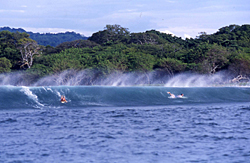
Warm water and offshore winds are a nice combination at Panga Drops, Nicaragua. Photo: Melissa Stevens
The best avocado I’ve ever eaten was on the shores of Lake Atitlán in northeastern Guatemala. The bright green fruit didn’t just taste good, it was made especially delicious by my state of mind. After two months of planning, packing and finally arriving in Central America, I felt an incredible sense of well-being and freedom. For it was only two months prior that we seemed inextricably bound to the daily grind. Now I was kicking back under the sun, carving off pieces of fresh fruit and sharing them with my husband, Jono.
How did we manage to slip away, to unleash ourselves from the shackles of our first-world possessions? What life-altering experiences and people would we encounter in the next four months on the road? Could we really find those dreamy un-crowded, corduroy-lined point breaks you see in surf guidebooks?
We were smitten by our situation, more than ready to wander down all the lesser-traveled Latin American dirt roads. As difficult as it first seemed to make our dream of traveling through Central and South America a reality, we did it. Here’s a snapshot of our journey; we hope it will inspire you to pull your adventure travel dreams off the shelf and bring them to life.
Traveling the world isn’t so hard. It’s the decision to do it, and the planning phase that really takes effort. Where to go and how long? How much money will it cost? Is it relatively safe? What do we absolutely need to bring or not bring? To answer these questions we relied on books (The World Stormrider Guide is a good start for surf info, and of course Lonely Planet guidebooks are invaluable for shoestring adventurers), the World Wide Web, and the most valuable resource of all – people who’ve already been there.
There are so many incredible countries in the world to visit, but it had been a personal ambition for both of us to visit Latin America. The diversity of cultures, economic feasibility, the ability to learn a valuable language, and the endless miles of breathtaking, surfable coastlines to explore made our choice clear: Latin America was our surf safari destination.
Bags and surfboards packed, house sub-letted, mail forwarded, finances arranged, hepatitis and yellow fever shots taken, medical kit stocked (malaria pills and a strong antibiotic like Cipro are good to take along just in case) … It seemed as though the greatest challenge was preparing for this trip!
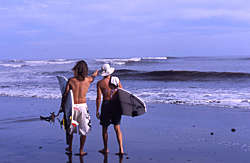
Melissa and Aussie Wayne scope the waves of El Zonte before a morning session, El Salvador.
Photo: Jono Stevens
Guatemala Bound
But the day finally came to fly south. We had decided to begin our journey in Guatemala, as it is known for having excellent Spanish-immersion courses where a motivated student can learn Spanish in a matter of weeks. Given the length of our travels (about five months) and the fact we were planning to go to some ‘rougher’ countries where English is not commonly spoken, the first order of business was learning the lingo.
The quaint colonial town of Antigua, Guatemala is a hot spot for studying Spanish, but on a friend’s recommendation we decided to go to a slightly less gringo-fied city in the northwestern highlands called Quetzaltenango (“Xela” for short). This area is home to people of the Quiché Maya culture, which is still very much alive today. We studied for a week at a wonderful school that provided one-on-one instruction as well as daily group activities. The school set us up with a gracious host family who welcomed us into their home and fed us incredible Guatemalan fare such as fresh pico de gallo, homemade tortillas and hot chicken soup.
Unfortunately, in tasting new and different foods in far off places, one thing is virtually guaranteed: You will get sick. Of course the degree of intensity varies. Usually you get over it quickly as your intestinal tract adjusts to hosting new microorganisms, but be sure to pack the Immodium for the interim. Waterless hand sanitizers are recommended to protect against bacteria contamination when there isn’t a sink nearby, as is often the case.
During our week at school we learned more than just Spanish. Many of the teachers there were of Mayan ancestry and had incredible stories to tell of the dark civil war years of the 1970s and ‘80s. As we absorbed the language, we also absorbed the reality of prejudice and brutal oppression that indigenous people have faced, and the poverty many of them live through today. We were shocked and somewhat ashamed to learn about covert U.S. involvement in the 1950s that sought to protect U.S. corporate interests by orchestrating a military coup, forcing then President Jocobo Arbenz Guzmán to step down. Guzmán sought labor reform and the redistribution of massive land estates among small farmers. His removal from office sunk the country further into chaos, violence and oppression, leading to a long civil war. Learning what was not taught in our history books began an awakening from the cocoon of our American perspective; a valuable gift that comes only from stepping outside one’s own borders.
Trying to learn Spanish in a week is like trying to build a house in a week – you can only get so far before you realize you’ve attempted the impossible. Still, it was a good foundation, and we knew there would be plenty more opportunities for schooling along the way. We were just itching to get to the coast and onto our surfboards. So, after a few more days of sight-seeing around Panajachel and Lake Atitlan, including some unforgettable boat and bus rides, we were off to the next country
Uncrowded El Salvadoran Surf
Lying southwest along the Pacific coastline are the countries of El Salvador and Nicaragua. War-ravaged for most of the 1980s (thanks in large part to the Reagan Administration), these two countries are slowly recovering but continue to struggle from extreme poverty, government corruption, and cultural clashes. We were worried for our safety in these countries after reading and hearing about numerous robberies and assaults. We knew there was a possibility of becoming targets for theft or worse, but continued to be drawn there by the thought of beautiful, uncrowded beaches and un-jaded, welcoming locals. Besides, where is the adventure in going where everyone else has been? We decided to go; we would just go carefully.
El Salvador was rumored to have some of the most consistent and uncrowded breaks in Central America. We found this to be true. In a 10-mile stretch of the coastal highway along the central Pacific, there are at least five point breaks and two beach breaks. Through a bit of luck we landed in a great little community near La Libertad, about 45 minutes from the capital of San Salvador.
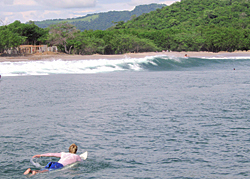
Arriving by boat, a view of the backside of the wave is all you get, until you’re in the barrel. Nicaragua.
Photo: Melissa Stevens.
At first glance it didn’t look so great; a very basic hostel with only one bathroom for six rooms (sans sink), a mattress that looked like it had also fought in the war, and a sorry looking little fan that would be our only savior from the sticky heat. But when we turned around and stood on the balcony overlooking a little river and a wide expanse of beach leading out to a fabulous point break, we realized we were in heaven. For ten days we surfed, slept, ate and relaxed alongside members of this tiny community and guests from all corners of the globe.
The waves were pretty consistent, big (8-10 foot faces) but gently peeling right, and good at just about any tide. The water was like warm chocolate milk, which was not in the least bit refreshing, particularly under the mid-day sun. In the dry season it is apparently clear and beautiful, but in October, a nightly deluge of rain engorged the muddy rivers flowing out to sea.
Unfortunately, much of the run-off contained untreated water. After a few nights of particularly horrendous downpours in which we watched the dirt road in front of our hostel become a small river in a matter of minutes, many of the surfers became ill, including us. With only one bathroom to share, and unable to surf for fear of getting sicker, it was time to move south and see if the surf rumors about Nicaragua were also true.
Gringo Adjustments
Flying to Managua from San Salvador was a piece of cake. Getting out of Managua was another story entirely. Like any big city, you have to use multiple combinations of transport to get where you want to go, and you have to be prepared to barter at each point along the way.
When you’re a gringo, the stage is automatically set for you to get ripped off. You have to get into a cab and trust that the driver is actually going to take you to the right place, and you must also trust that when you arrive at the bus station the guys grabbing your luggage from the trunk and running off into the bus station have some idea where you are going. They always say, “Hurry! The bus is leaving now!” So you rush to get on the bus, hoping that your luggage makes it to the top of the same rig, and wait for the driver to start the engine. It’s hot and you are crammed in tighter than a Tokyo subway. You wait and wait until you realize that time is metered entirely different here. Nothing is “on-time,” things just happen when they happen. It’s a perspective that most North Americans have long forgotten, but with extended immersion becomes a welcome, relaxing change of cadence.
Anyone who’s traveled in Central America knows the buses are the countries’ lifelines, and also a roving reflection of the culture in each area. Each bus is extravagantly decorated (tassels, paint, religious paraphernalia), named (usually after a woman), and driven as intensely as the smile on the man behind the wheel. There seems to be no limit to the number of people crammed into the seats and aisles. Bus stations are not only transportation centers, but most also act as huge markets and are therefore a constant flurry of activity. This atmosphere for a traveler with a heavy load and minor grasp on the language is intense, to say the least. Particularly in big cities, our M.O. was to “get in and get the hell out as fast as we can.”
It is an entirely new perspective to be the odd ones in a crowd. Being white and carrying modern backpacks and surfboards made us stand out like hippies in Winnemucca. Our purpose was also very different. Everyone around us was going to work or school, going shopping; living their daily lives. We were vacationers in the midst of this, and I wonder if the natives thought we were crazy Americans for wanting to come see what they get up to every day. Perhaps many locals living in big cities don’t know the beauty of their own country. Many of them are unable to travel more than a few miles from home. While a few looks we received were disapproving, most were looks of curiosity and excitement, especially from the children. When we gave them stickers or a small toy, they would light up with joy.
San Juan del Sur, Nicaragua
Surfing in Nicaragua is something of a logistical feat, but well worth the effort. The craggy coastline along its southwestern end complements the incoming Pacific swell, with numerous point and reef breaks set like fine wrinkles on the edge of smiling bays. And after El Salvador, the clear aquamarine water was a relief.
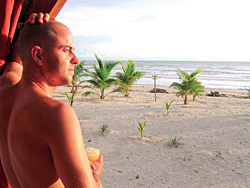
Jono enjoys the sunset with a cold drink after a long day at the office. Mal Pais, Costa Rica.
Photo: Melissa Stevens
Most of the surf activity is centered in the unassuming little town of San Juan del Sur, about a two-and-a-half hour bus ride from Managua. San Juan sits in the middle of a gorgeous horseshoe-shaped bay. In fact, it is one of many bays going north which makes getting to the breaks by car rather tricky. The dirt roads along the coast are indirect and bumpy, so it was often more effective and pleasant to take a boat. There were a handful of operators to choose from; their vessels ranged from a 12-foot panga ($US 10/person) to a 25-foot cruiser ($US 75/person).
Our first day out in Nicaragua was spectacular. We saw turtles and dolphins along the way, seabirds chasing schools of fish, and even a whale off in the distance. Cruising north from San Juan, we were able to pick and choose which breaks looked good and most days there just wasn’t enough time to jump in to all of them.
During our stay in San Juan we met people from all over the world, mostly younger active types looking for a memorable wave. The vibe was mellow, people were friendly and helped each other with logistics. Everyone was stoked to be there. The local surfers were generally friendly, and they ripped. I saw tricks on a boogie board (surfboards are hard to come by down there) that I couldn’t have dreamed possible.
We also took a week to check out Lake Nicaragua (the largest lake in Central America) and the island of Ometepe, created by two stunning volcanoes, the active Volcán Concepción (1,610 meters) and Volcán Maderas (1,394 meters), now extinct. Still quite untouched by tourism (but changing fast), the island is home to small villages of fishermen and farmers growing bananas, coffee, maize and sesame.
After a few days of hiking and rough accommodations we decided to head to the beautiful colonial city of Granada, located on the northwestern shores of Lake Nicaragua. Granada is Nicaragua’s oldest Spanish city, founded in 1524. It is big enough for an influx of modern luxuries (fancy hotels, nice cars, etc.), but retains its colonial mystique with countless churches, Spanish courtyards and cobblestone streets.
Returning to San Juan, I decided to sign up for another week of Spanish while Jono, who started the trip with a pretty good handle on the language, concentrated on his bottom turns. In a short amount of time we became more ensconced in the town, taking part in their Independence Day celebration and living with another local family. A month flew by and we found ourselves reluctant to leave.
After a few more good surf days and many goodbyes, we finally tore ourselves away from San Juan and crossed the border into Costa Rica.
Costa Rican Letdown
We rented a car in Liberia, which felt like an incredible luxury after hoofing our gear on and off buses. We set off inland towards Fortuna, an eco-adventure tourism hot spot at the foot of the very active Volcan Arenal (1,633 meters). At night we sat in hot springs and watched fiery red lava spewing from its top, and by day we wandered down rivers looking for crocodiles and bright green tree frogs, and traveled around the mountain on horseback.
After that it was back toward the coast, to the Nicoya Peninsula and the surf towns of Tamarindo, Nosara and Mal Pais. Unfortunately, everywhere we went that week we got skunked by the weather – too much wind and no surf.
Perhaps it was partially the weather, but Costa Rica was a bit of a letdown after such genuine and enriching experiences in El Salvador and Nicaragua. It was almost as if we had stepped back into the states, prices and all. There were fast food restaurants, big gas stations and grocery stores, nicer cars. We could see right away the double-edged sword of tourism, which brings a much-needed boost to the economy but irrevocably alters the landscape and the natural way of living.
The people of Costa Rica, Ticos as they are called, seem to embody this bittersweet trade-off by politely distancing themselves from tourists. Everything seems to be for sale, and I wondered how much profit actually made it into the hands of people living there. I don’t fault Costa Ricans for inviting “opportunity,” but I was dismayed by the thought that Nicaragua and even El Salvador may eventually be run-over by the tourist dollar and change forever too. This is an unfortunate effect of our presence, and for a moment I felt guilty for being there at all. I shook it off, reasoning that our presence, and the perspective we gained, would far outweigh any negative impacts. I like to think we were good ambassadors and had a positive influence on the lives we touched.
The time we spent in traveling in Central America was culturally rich and personally rewarding. We were blessed with good luck and generally good health. We managed to travel safely and keep our belongings intact. We were glad we knew some Spanish; without it many connections would not have been made, and probably many more dollars would have been lost.
With each passing day, our first-world cocoon was slowly dissolved; more accepting, willing and relaxed people emerged. We learned to put away expectations and to keep everything in perspective. We saw people struggling to live, but who exuded happiness and good will even when they had almost nothing – a lesson that we have tried to keep in mind as we assimilated back into our workaday lives. Traveling brings us closer to accepting whatever each day brings, and being grateful to receive it. This is, after all, the ultimate gift.
Our epic trip continued on to South America, where we found colder water, some great surfing, trekked the Inca Trail to Machu Picchu and absorbed many more cultural adventures. But that portion of the journey, will have to wait to be told another time.
If you would like more information about places, please email the author at melmstevens@yahoo.com.

